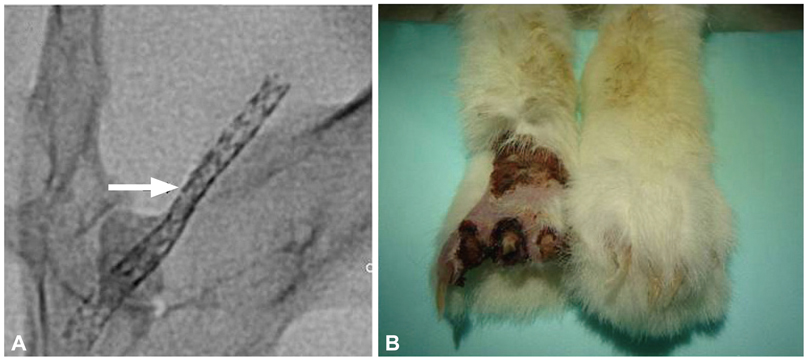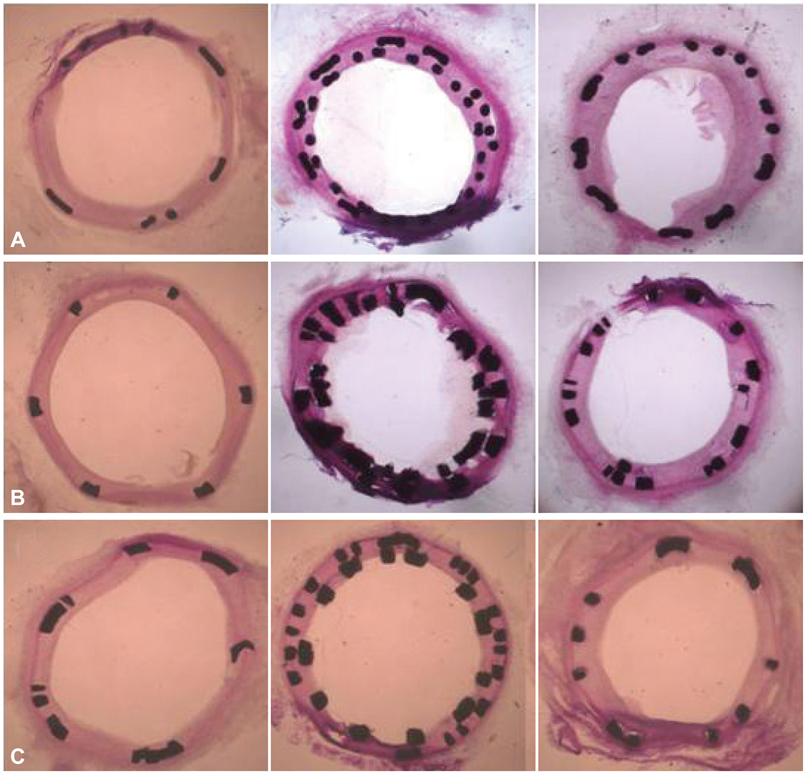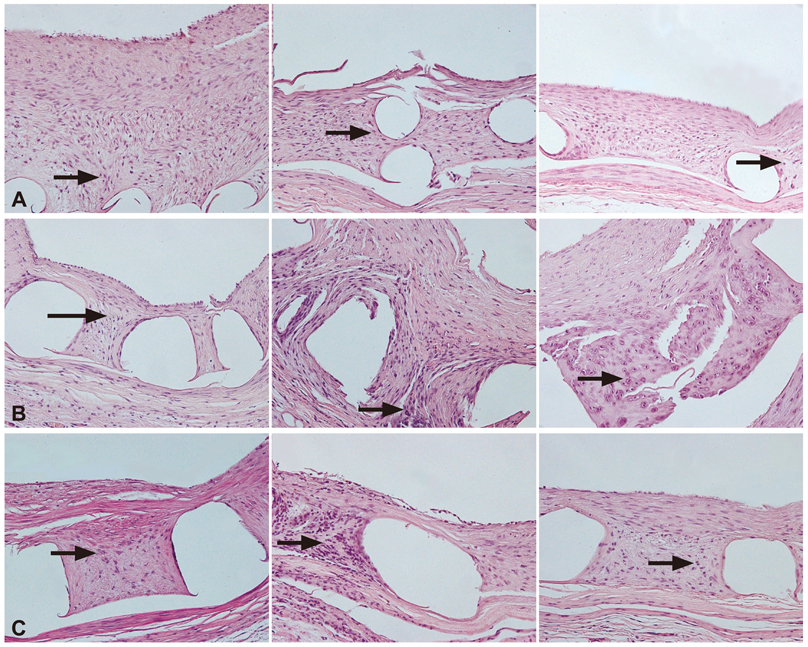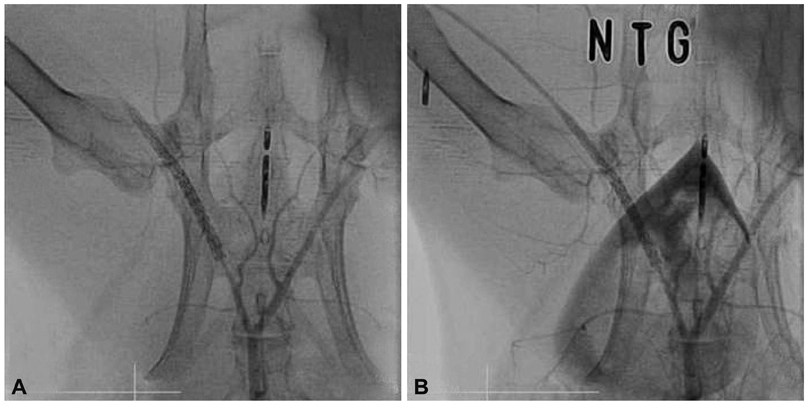Korean Circ J.
2012 Jun;42(6):397-405. 10.4070/kcj.2012.42.6.397.
Impact of Heterogeneous Overlapping Drug-Eluting Stents on the Arterial Responses of Rabbit Iliac Arteries: A Comparison With Overlapping Bare Metal Stents
- Affiliations
-
- 1Cardiovascular Center, Korea University Guro Hospital, Seoul, Korea. mddjoh@medimail.co.kr
- 2Cardiology Department, The Second Hospital of Tianjin Medical University, Tianjin, China.
- 3Cardiology Department, Tianjin Nankai Hospital, Tianjin, China.
- 4Cardiovascular Center, Chonnam National University Hospital, Gwangju, Korea.
- KMID: 1433859
- DOI: http://doi.org/10.4070/kcj.2012.42.6.397
Abstract
- BACKGROUND AND OBJECTIVES
Although the use of heterogeneous overlapping drug-eluting stents (DES) is not uncommon in clinical practice, whether the implantation sequences of heterogeneous DES will influence the endothelialization or arterial responses differently remains unclear.
MATERIALS AND METHODS
Twenty-one rabbits were randomized to receive overlapping stents in the iliac artery for 3 months {distal sirolimus-eluting stent (SES, Cypher(TM))+proximal paclitaxel-eluting stent (PES, Taxus(TM)) (C+T, n=7), distal Taxus+proximal Cypher (T+C, n=7) and bare metal stent (BMS)+BMS (B+B, n=7)}. Endothelial function was evaluated by the acetylcholine provocation test during follow-up angiography. Histopathological changes in proximal, overlapped, and distal stented segments were evaluated.
RESULTS
Although the overall angiographic outcomes were comparable, late loss (mm) in the distal stented segment was higher in the B+B (0.39+/-0.07) and C+T (0.40+/-0.20) than that in the T+C (0.06+/-0.02) group (p<0.001). The incidence of acetylcholine-induced spasm was higher in the DES groups compared with BMS, regardless of the implantation sequences (85.7% in C+T vs. 14.3% in B+B vs. 71.4% in T+C, p=0.017). Notably, only the distal Cypher implantation group (C+T) had three cases of stent fracture. A histopathological analysis showed that despite similar arterial injury scores, Taxus and Cypher stents had higher inflammatory reactions at the overlapped and distal segments compared with those of BMS.
CONCLUSION
Despite similar arterial injury, higher inflammatory reactions were observed in overlapping DES segments regardless of the implantation sequence compared with that of BMS. Moreover, DES was associated with impaired endothelial function on the adjacent non-stented segments.
Keyword
MeSH Terms
Figure
Reference
-
1. Kang WC, Oh KJ, Han SH, et al. Angiographic and intravascular ultrasound study of the effects of overlapping sirolimus- and paclitaxel-eluting stents: comparison with same drug-eluting overlapping stents. Int J Cardiol. 2007. 123:12–17.2. Her SH, Yoo KD, Park CS, et al. Long-term clinical outcomes of overlapping heterogeneous drug-eluting stents compared with homogeneous drug-eluting stents. Heart. 2011. 97:1501–1506.3. Kim JW, Seo HS, Park JH, et al. A prospective, randomized, 6-month comparison of the coronary vasomotor response associated with a zotarolimus- versus a sirolimus-eluting stent: differential recovery of coronary endothelial dysfunction. J Am Coll Cardiol. 2009. 53:1653–1659.4. Obata JE, Kitta Y, Takano H, et al. Sirolimus-eluting stent implantation aggravates endothelial vasomotor dysfunction in the infarct-related coronary artery in patients with acute myocardial infarction. J Am Coll Cardiol. 2007. 50:1305–1309.5. Lim SY, Jeong MH, Hong SJ, et al. Inflammation and delayed endothelization with overlapping drug-eluting stents in a porcine model of in-stent restenosis. Circ J. 2008. 72:463–468.6. Lim SY, Bae EH, Jeong MH, et al. Effect of alpha lipoic acid in a porcine in-stent restenosis model. J Cardiol. 2009. 54:375–385.7. Schwartz RS, Huber KC, Murphy JG, et al. Restenosis and the proportional neointimal response to coronary artery injury: results in a porcine model. J Am Coll Cardiol. 1992. 19:267–274.8. Hong YJ, Jeong MH, Lee SR, et al. Anti-inflammatory effect of abciximab-coated stent in a porcine coronary restenosis model. J Korean Med Sci. 2007. 22:802–809.9. Serruys PW, Foley DP, Suttorp MJ, et al. A randomized comparison of the value of additional stenting after optimal balloon angioplasty for long coronary lesions: final results of the additional value of NIR stents for treatment of long coronary lesions (ADVANCE) study. J Am Coll Cardiol. 2002. 39:393–399.10. Colombo A, Chieffo A. Drug-eluting stent update 2007: part III: technique and unapproved/unsettled indications (left main, bifurcations, chronic total occlusions, small vessels and long lesions, saphenous vein grafts, acute myocardial infarctions, and multivessel disease). Circulation. 2007. 116:1424–1432.11. Tsagalou E, Chieffo A, Iakovou I, et al. Multiple overlapping drug-eluting stents to treat diffuse disease of the left anterior descending coronary artery. J Am Coll Cardiol. 2005. 45:1570–1573.12. Chu WW, Kuchulakanti PK, Torguson R, et al. Comparison of clinical outcomes of overlapping sirolimus- versus paclitaxel-eluting stents in patients undergoing percutaneous coronary intervention. Am J Cardiol. 2006. 98:1563–1566.13. Holmes DR Jr, Kereiakes DJ, Garg S, et al. Stent thrombosis. J Am Coll Cardiol. 2010. 56:1357–1365.14. Nakazawa G, Finn AV, Joner M, et al. Delayed arterial healing and increased late stent thrombosis at culprit sites after drug-eluting stent placement for acute myocardial infarction patients: an autopsy study. Circulation. 2008. 118:1138–1145.15. Cook S, Ladich E, Nakazawa G, et al. Correlation of intravascular ultrasound findings with histopathological analysis of thrombus aspirates in patients with very late drug-eluting stent thrombosis. Circulation. 2009. 120:391–399.16. Finn AV, Kolodgie FD, Harnek J, et al. Differential response of delayed healing and persistent inflammation at sites of overlapping sirolimus- or paclitaxel-eluting stents. Circulation. 2005. 112:270–278.17. Wilson GJ, Nakazawa G, Schwartz RS, et al. Comparison of inflammatory response after implantation of sirolimus- and paclitaxel-eluting stents in porcine coronary arteries. Circulation. 2009. 120:141–149.18. Shinke T, Li J, Chen JP, et al. High incidence of intramural thrombus after overlapping paclitaxel-eluting stent implantation: angioscopic and histopathologic analysis in porcine coronary arteries. Circ Cardiovasc Interv. 2008. 1:28–35.19. Chhatriwalla AK, Cam A, Unzek S, et al. Drug-eluting stent fracture and acute coronary syndrome. Cardiovasc Revasc Med. 2009. 10:166–171.
- Full Text Links
- Actions
-
Cited
- CITED
-
- Close
- Share
- Similar articles
-
- A Case of Neointimal Calcification in a Drug-Eluting Stent
- Is There a Benefit of Drug-Eluting Stents Rather than Bare Metal Stents in Large Coronary Artery Lesions?
- Optical Coherence Tomography-guided Treatment of Multiple Stent Fracture in Patients with Overlapping Drug-eluting Stents
- Treatment of Diffuse Long Coronary Artery Disease with Overlapping Drug-Eluting Stents is Effective?
- Usefulness of Drug-Eluting Stents in Angioplasty and Stenting of the Vertebral Artery Origin : Comparison with Bare Stents: Clinical Research





